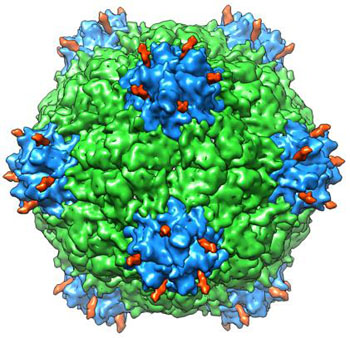New X-Ray Crystallography Study Confirms Structure of Empty Cowpea mosaic virus Particles
By LabMedica International staff writers
Posted on 10 Apr 2016
An X-ray crystallography study confirmed that empty Cowpea mosaic virus (CPMV) particles (eVLPs) were structurally similar to the intact virus and showed that they could be used for drug transport and other biomedical applications.Posted on 10 Apr 2016
CPMV is a plant virus of the Comovirus group. Its genome consists of two molecules of positive-sense RNA, which are separately encapsulated. The virus particles are 28 nanometers in diameter and contain 60 copies each of a Large (L) and Small (S) coat protein. The structure is well characterized to atomic resolution, and the viral particles are thermostable. CPMV displays a number of features that can be exploited for nanoscale biomaterial fabrication. Its genetic, biological, and physical properties are well characterized, and it can be isolated readily from plants. There are many stable mutants already prepared that allow specific modification of the capsid surface. It is possible to attach a number of different chemicals to the virus surface and to construct multilayer arrays of such nanoparticles on solid surfaces. This gives the natural or genetically engineered nanoparticles a range of properties which could be useful in nanotechnological applications such as biosensors, catalysis and nanoelectronic devices.

Image: A study shows that a hollowed-out version of Cowpea mosaic virus could be useful in human therapies (Photo courtesy of the Scripps Research Institute).
Empty CPMV particles (eVLPs) can be modified to entrap drugs or other molecules while the outside surface can be coated with peptides that direct the particles to a specific class of target cells.
Investigators at The Scripps Research Institute (La Jolla, CA, USA) reported in the March 24, 2016, online edition of the journal Structure that they had used X-ray crystallography at 2.3 angstrom resolution to determine the crystal structure of CPMV eVLPs and then compared it to previously reported cryo-electron microscopy (cryo-EM) reports of eVLPs and virion crystal structures.
The new study revealed that although the X-ray and cryo-EM structures of eVLPs were mostly similar, there existed significant differences at the C-terminus of the small (S) subunit. The intact C-terminus of the S subunit plays a critical role in enabling the efficient assembly of CPMV virions and eVLPs, but undergoes proteolysis after particle formation. In addition, the results of mass spectrometry-based proteomics analysis of coat protein subunits from CPMV eVLPs and virions showed that the C-termini of S subunits underwent proteolytic cleavages at multiple sites instead of a single cleavage site as previously observed.
"By studying the structure of the viral particles, we can get important information for transforming this plant virus into a useful therapeutic," said senior author Dr. Vijay Reddy, an associate professor at The Scripps Research Institute. "The eVLP is no longer a virus; it is just a protein capsule."
Related Links:
The Scripps Research Institute













